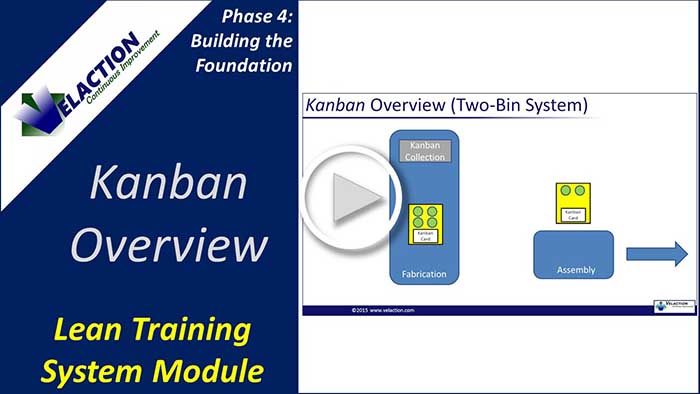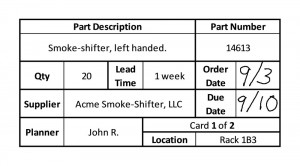🛠 > Lean Forms & Tools Directory > Download Free Forms & Tools
Kanban Card
A kanban card is small card containing information about a specific part used in production. It is a signal that tells someone upstream to move, purchase, or build more of a component for production.
These cards must contain the number of units (items, pounds, kits, etc.) that need action. They also likely contain a variety of other information that clearly conveys what must be done.
A kanban card often has a place to write the date it was turned in, or “dropped”, and when it is due, calculated by adding the lead time to the turn-in date.
 Watch Our Kanban Overview Video
Watch Our Kanban Overview Video

While the specific information contained on a kanban card can vary, most will contain at least some of the following information:
- Part description
- Part/Item number
- An identifying bar code
- The quantity of parts to be moved/produced/ordered
- Routing information / upstream or downstream processes
- Location information
- Lead time
- Supplier
- The responsible person, usually a planner
- The order date
- The due date
- Type of container
- Number of containers (i.e. card 2 of 4)
Cards are often fixed to a container, effectively turning the bin or cart itself into a kanban. In other cases, a kanban card is simply laminated and temporarily attached to shelves or bins with hook and pile fasteners.
These signal cards are an integral part of a kanban system to manage inventory. As such, a kanban card should be treated like a controlled item—losing one can shut down a production line.
Kanban cards should be managed by a documented process. For example, the process should clarify where to “drop” the cards, whether to drop them when the first item is drawn or when the bin is empty, and what to do with the cards once an order is placed.
There are a variety of formulas used to determine the quantity shown on a kanban card. In a nutshell, the math is designed to make sure that you still have parts available, but only a minimal number, when the next order arrives. The calculations factor in minimum order quantities, pack sizes, lead time, and in some cases, even vendor reliability. Some formulas use sophisticated statistics and historical order information. Others are much less sophisticated and use a simple calculation with an added safety stock.

Kanban Card Risks
- A lost card can cause a shortage. Treat them like a controlled item.
- Don’t game the system. If extra parts are being stashed, it is an indication that the kanban cards are not showing the correct quantity.
- Keep the cards updated. Outdated cards can lead to stock outs.
- Kanban cards do not reduce inventory. They manage it.
- Kanban cards need stable environments to run effectively. If your demand swings wildly or you don’t have effective standard work, your replenishment system will struggle.
- Reliable suppliers are critical to the use of kanban If they can’t consistently meet the promised lead times with good quality, you’ll need far more safety stock.

Kanban cards will make your life easier, even though there is something new to deal with in your job. Because they are right where the parts are, they make problems highly apparent. Computerized material management systems are only as good as the information reported to them. Having the cards right at the point of use highlights issues. This, however, means that you have to understand the system and have to take action when you recognize a problem.
There is a benefit that comes with this extra work, though. You will face fewer stock outs and will have an easier time getting the materials you need to do your job.

Kanban systems are effective, but they are not easy. You’ll have to spend the time to create a process to manage your kanban cards. You’ll have to designate an area to produce the cards to meet the continuous need for new ones. You’ll need to provide the materials to make the cards.
Most of all, you’ll need to provide the leadership and industrial discipline to keep the system operating smoothly.

Key Points About Using Kanban Cards
- Kanban cards don’t reduce inventory. They manage it.
- Kanban cards signal to move/withdrawal, produce, or order items.
- If a kanban card is lost, you’ll end up with a parts shortage. Treat them like gold.
![]()
If you are not already using kanban cards, do a test in a pilot area. Figure out the nuances of using them in your environment. As you test them, build and document your process.
Once you have the shell of a process developed, roll it out on a wider scale and run it for a period of time. Some of the issues with a kanban system don’t show up unless the stars all fall into a certain alignment. During this testing period, work on ironing out the bugs so when you implement your kanban system factory wide, you’ll encounter fewer problems.

0 Comments